Estimating Structural Damage to Mangrove Forests Using Airborne Lidar Imagery: Case Study of Damage Induced by the 2017 Hurricane Irma to Mangroves in the Florida Everglades, USA
Abstract
:1. Introduction
2. Background
2.1. Mangroves of the Everglades National Park
2.2. The 2017 Hurricane Irma
2.3. NASA’s G-LiHT
3. Data
3.1. Lidar Datasets
3.2. Field Measurements
4. Methods
4.1. Lidar Data Extraction
4.2. Field-Based Estimates of AG, WD, and AGTM
4.3. AGN and WD Regression Models and Modeled AGTM
4.4. Uncertainty Analysis
4.5. Upscaling
5. Results
5.1. Point Cloud Generation
5.2. Field-Based Estimates of AGN, WD, and AGTM
5.3. Regression Models
5.4. Upscaling
5.5. Ratio between AGN and AGTM
6. Discussion
7. Conclusions
Supplementary Materials
Author Contributions
Funding
Institutional Review Board Statement
Informed Consent Statement
Data Availability Statement
Acknowledgments
Conflicts of Interest
References
- Jerath, M.; Bhat, M.; Rivera-Monroy, V.H.; Castañeda-Moya, E.; Simard, M.; Twilley, R.R. The Role of Economic, Policy, and Ecological Factors in Estimating the Value of Carbon Stocks in Everglades Mangrove Forests, South Florida, USA. Environ. Sci. Policy 2016, 66, 160–169. [Google Scholar] [CrossRef] [Green Version]
- Hochard, J.P.; Hamilton, S.; Barbier, E.B. Mangroves Shelter Coastal Economic Activity from Cyclones. Proc. Natl. Acad. Sci. USA 2019, 116, 12232–12237. [Google Scholar] [CrossRef] [PubMed] [Green Version]
- Menéndez, P.; Losada, I.J.; Torres-Ortega, S.; Narayan, S.; Beck, M.W. The Global Flood Protection Benefits of Mangroves. Sci. Rep. 2020, 10, 4404. [Google Scholar] [CrossRef] [Green Version]
- Narayan, S.; Thomas, C.; Matthewman, J.; Shepard, C.C.; Geselbracht, L.; Nzerem, K.; Beck, M.W. Valuing the Flood Risk Reduction Benefits of Florida’s Mangroves; The Nature Conservancy: Arlington, VA, USA, 2019. [Google Scholar]
- Goldberg, L.; Lagomasino, D.; Thomas, N.; Fatoyinbo, T. Global Declines in Human-Driven Mangrove Loss. Glob. Chang. Biol. 2020, 26, 5844–5855. [Google Scholar] [CrossRef] [PubMed]
- Smith, T.J.; Anderson, G.H.; Baletine, K.; Tiling, G. Cumulative Impacts of Hurricanes on Florida Mangrove Ecosystems: Sediment Deposition, Storm Surges and Vegetation. Wetlands 2009, 29, 24–34. [Google Scholar] [CrossRef]
- Castaneda-Moya, E.; Rivera-Monroy, V.H.; Chambers, R.M.; Hiatt, M. Hurricanes Fertilize Mangrove Forests in the Gulf of Mexico (Florida Everglades, USA). Proc. Natl. Acad. Sci. USA 2020, 117, 4831–4841. [Google Scholar] [CrossRef]
- Lagomasino, D.; Fatoyinbo, T.; Castañeda-Moya, E.; Cook, B.D.; Montesano, P.M.; Neigh, C.S.R.; Corp, L.A.; Ott, L.E.; Chavez, S.; Morton, D.C. Storm Surge and Ponding Explain Mangrove Dieback in Southwest Florida Following Hurricane Irma. Nat. Commun. 2021, 12, 4003. [Google Scholar] [CrossRef]
- Xiong, L.; Lagomasino, D.; Charles, S.P.; Castañeda-Moya, E.; Cook, B.D.; Redwine, J.; Fatoyinbo, L. Quantifying Mangrove Canopy Regrowth and Recovery after Hurricane Irma with Large-Scale Repeat Airborne Lidar in the Florida Everglades. Int. J. Appl. Earth Obs. Geoinf. 2022, 114, 103031. [Google Scholar] [CrossRef]
- Han, X.; Feng, L.; Hu, C.; Kramer, P. Hurricane-Induced Changes in the Everglades National Park Mangrove Forest: Landsat Observations Between 1985 and 2017. JGR Biogeosci. 2018, 123, 3470–3488. [Google Scholar] [CrossRef]
- Wang, Y. Detecting Vegetation Recovery Patterns after Hurricanes in South Florida Using NDVI Time Series; University of Miami: Coral Gables, FL, USA, 2012. [Google Scholar]
- Zhang, K.; Simard, M.; Ross, M.; Rivera-Monroy, V.H.; Houle, P.; Ruiz, P.; Tilley, R.R.; Whelan, K. Airborne Laser Scanning Quantification of Disturbances from Hurricanes and Lightning Strikes to Mangrove Forests in Everglades National Park, USA. Sensors 2008, 8, 2262–2292. [Google Scholar] [CrossRef] [Green Version]
- Gao, Q.; Yu, M. Elevation Regimes Modulated the Responses of Canopy Structure of Coastal Mangrove Forests to Hurricane Damage. Remote Sens. 2022, 14, 1497. [Google Scholar] [CrossRef]
- Simard, M.; Zhang, K.; Rivera-Monroy, V.H.; Ross, M.S.; Ruiz, P.L.; Castañeda-Moya, E.; Twilley, R.R.; Rodriguez, E. Mapping Height and Biomass of Mangrove Forests in Everglades National Park with SRTM Elevation Data. Photogramm. Eng. Remote Sens. 2006, 72, 299–311. [Google Scholar] [CrossRef]
- Castaneda-Moya, E.; Twilley, R.R.; Rivera-Monroy, V.H. Allocation of Biomass and Net Primary Productivity of Mangrove Forests along Environmental Gradients in the Florida Coastal Everglades, USA. For. Ecol. Manag. 2013, 307, 226–241. [Google Scholar] [CrossRef]
- Feliciano, E.A.; Wdowinski, S.; Potts, M.D.; Lee, S.-K.; Fatoyinbo, T.E. Estimating Mangrove Canopy Height and Above-Ground Biomass in the Everglades National Park with Airborne LiDAR and TanDEM-X Data. Remote Sens. 2017, 9, 702. [Google Scholar] [CrossRef] [Green Version]
- Duever, M.; Meeder, J.; Meeder, L.; Mccollom, J. Everglades: The Climate of South Florida and Its Role in Shaping the Everglades Ecosystem; Davis, S., Ogden, J.C., Eds.; CRC Press: Boca Raton, FL, USA, 1994. [Google Scholar]
- Cangialosi, J.P.; Latto, A.S.; Berg, R. Hurricane Irma. National Hurricane Center Tropical Cyclone Report 2018; National Hurricane Center: Miami, FL, USA, 2018. [Google Scholar]
- Cook, B.D.; Corp, L.A.; Nelson, R.F.; Middleton, E.M.; Morton, D.C.; McCorkel, J.T.; Masek, J.G.; Ranson, K.J.; Ly, V.; Montesano, P.M. NASA Goddard’s LiDAR, Hyperspectral and Thermal (G-LiHT) Airborne Imager. Remote Sens. 2013, 5, 4045–4066. [Google Scholar] [CrossRef] [Green Version]
- Gaiser, E.E. NSF RAPID Hurricane Irma; Annual Report to the National Science Foundation; National Science Foundation: Washington, DC, USA, 2018. [Google Scholar]
- Roussel, J.-R.; Auty, D. Airborne LiDAR Data Manipulation and Visualization for Forestry Applications 2023; GitHub: London, UK, 2023. [Google Scholar]
- Lugo, A.E.; Snedaker, S.C. The Ecology of Mangroves. Annu. Rev. Ecol. Syst. 1974, 5, 39–64. [Google Scholar] [CrossRef]
- Wagner, C.E.V. The Line Intersect Method in Forest Fuel Sampling. For. Sci. 1968, 14, 20–26. [Google Scholar]
- Brown, J.K. Handbook for Inventorying Downed Woody Debris; USDA Forest Service General: Ogden, UT, USA, 1974. [Google Scholar]
- Allen, J.A.; Ewel, K.C.; Keeland, B.D.; Tara, T.; Smith, T.J. Downed Wood in Micronesian Mangrove Forests. Wetlands 2000, 20, 169–176. [Google Scholar] [CrossRef]
- Smith, T.J., III; Whelan, K. Development of Allometric Relations for Three Mangrove Species in South Florida for Use in the Greater Everglades Ecosystem Restoration. Wetl. Ecol. Manag. 2006, 14, 409–419. [Google Scholar] [CrossRef]
- Pedregosa, F.; Varoquaux, G.; Gramfort, A.; Michel, V.; Thirion, B.; Grisel, O.; Blondel, M.; Prettenhofer, P.; Weiss, R.; Dubourg, V.; et al. Scikit-Learn: Machine Learning in Python. J. Mach. Learn. Res. 2011, 12, 2825–2830. [Google Scholar]
- Anonymous. Mangrove Map—Everglades National Park; National Park Service: Washington, DC, USA, 2015. [Google Scholar]
- Davis, S.E.; Cable, J.E.; Childers, D.L.; Coronado-Molina, C.; Day, J.W.; Hittle, C.D.; Madden, C.J.; Reyes, E.; Rudnick, D.; Sklar, F. Importance of Storm Events in Controlling Ecosystem Structure and Function in a Florida Gulf Coast Estuary. J. Coast. Res. 2004, 20, 1198–1208. [Google Scholar] [CrossRef]
- Castañeda-Moya, E.; Twilley, R.R.; Rivera-Monroy, V.H.; Zhang, K.; Davis, S.E.; Ross, M. Sediment and Nutrient Deposition Associated with Hurricane Wilma in Mangroves of the Florida Coastal Everglades. Estuaries Coasts 2010, 33, 45–58. [Google Scholar] [CrossRef]
- Yanagisawa, H.; Koshimura, S.; Miyag, T.; Imamura, F. Tsunami Damage Reduction Performance of a Mangrove Forest in Banda Aceh, Indonesia Inferred from Field Data and a Numerical Model. J. Geophys. Res. Ocean. 2010, 115, C06032. [Google Scholar] [CrossRef] [Green Version]
- Holland, G.J. The Maximum Potential Intensity of Tropical Cyclones. J. Atmos. Sci. 1997, 54, 2519–2541. [Google Scholar] [CrossRef]
- Knutson, T.R.; McBride, J.L.; Chan, J.; Emanuel, K.; Holland, G.; Landsea, C.; Held, I.; Kossin, J.P.; Srivastava, A.K.; Sugi, M. Tropical Cyclones and Climate Change. Nat. Geosci. 2010, 3, 157–163. [Google Scholar] [CrossRef] [Green Version]
- Radabaugh, K.R.; Moyer, R.P.; Chappel, A.R.; Dontis, E.E.; Russo, C.E.; Joyse, K.M.; Bownik, M.W.; Goeckner, A.H.; Khan, N.S. Mangrove Damage, Delayed Mortality, and Early Recovery Following Hurricane Irma at Two Landfall Sites in Southwest Florida, USA. Estuaries Coasts 2020, 43, 1104–1118. [Google Scholar] [CrossRef]
- Rivera-Monroy, V.H.; Danielson, T.M.; Castañeda-Moya, E.; Marx, B.D.; Travieso, R.; Zhao, X.; Gaiser, E.E.; Farfan, L.M. Long-Term Demography and Stem Productivity of Everglades Mangrove Forests (Florida, USA): Resistance to Hurricane Disturbance. For. Ecol. Manag. 2019, 440, 79–91. [Google Scholar] [CrossRef]
- Krauss, K.W.; Doyle, T.W.; Twilley, R.R.; Smith, T.J.; Whelan, K.R.T.; Sullivan, J.K. Woody Debris in the Mangrove Forests of South Florida. Biotropica 2005, 37, 9–15. [Google Scholar] [CrossRef]
- Peneva-Reed, E.I.; Krauss, K.W.; Bullock, E.L.; Zhu, Z.; Woltz, V.L.; Drexler, J.Z.; Conrad, J.R.; Stehman, S.V. Carbon Stock Losses and Recovery Observed for a Mangrove Ecosystem Following a Major Hurricane in Southwest Florida. Estuar. Coast. Shelf Sci. 2020, 248, 106750. [Google Scholar] [CrossRef]
- Barr, J.G.; Engel, V.; Smith, T.J.; Fuentes, J.D. Hurricane Disturbance and Recovery of Energy Balance, CO2 Fluxes and Canopy Structure in a Mangrove Forest of the Florida Everglades. Agric. For. Meteorol. 2012, 153, 54–66. [Google Scholar] [CrossRef] [Green Version]
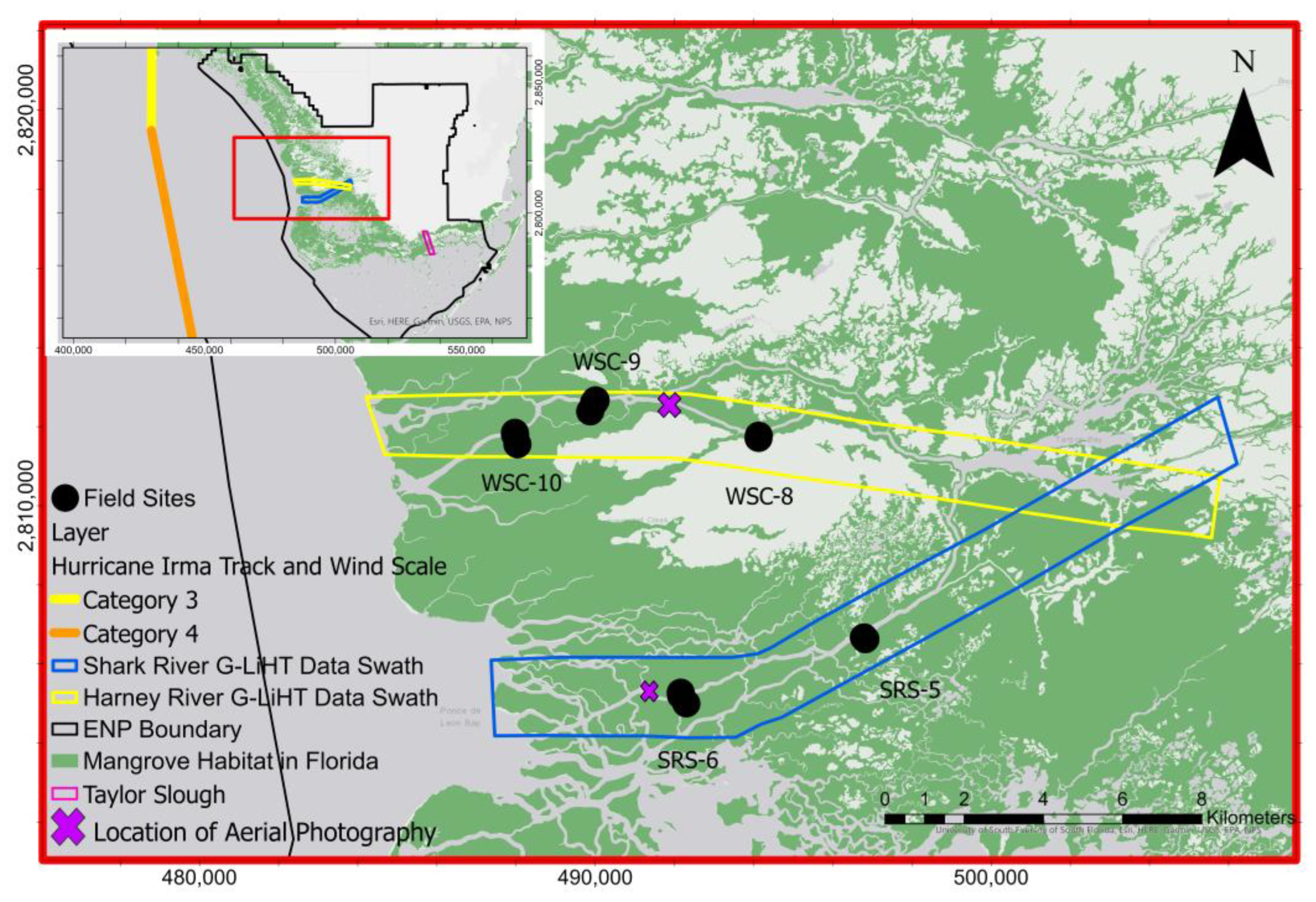
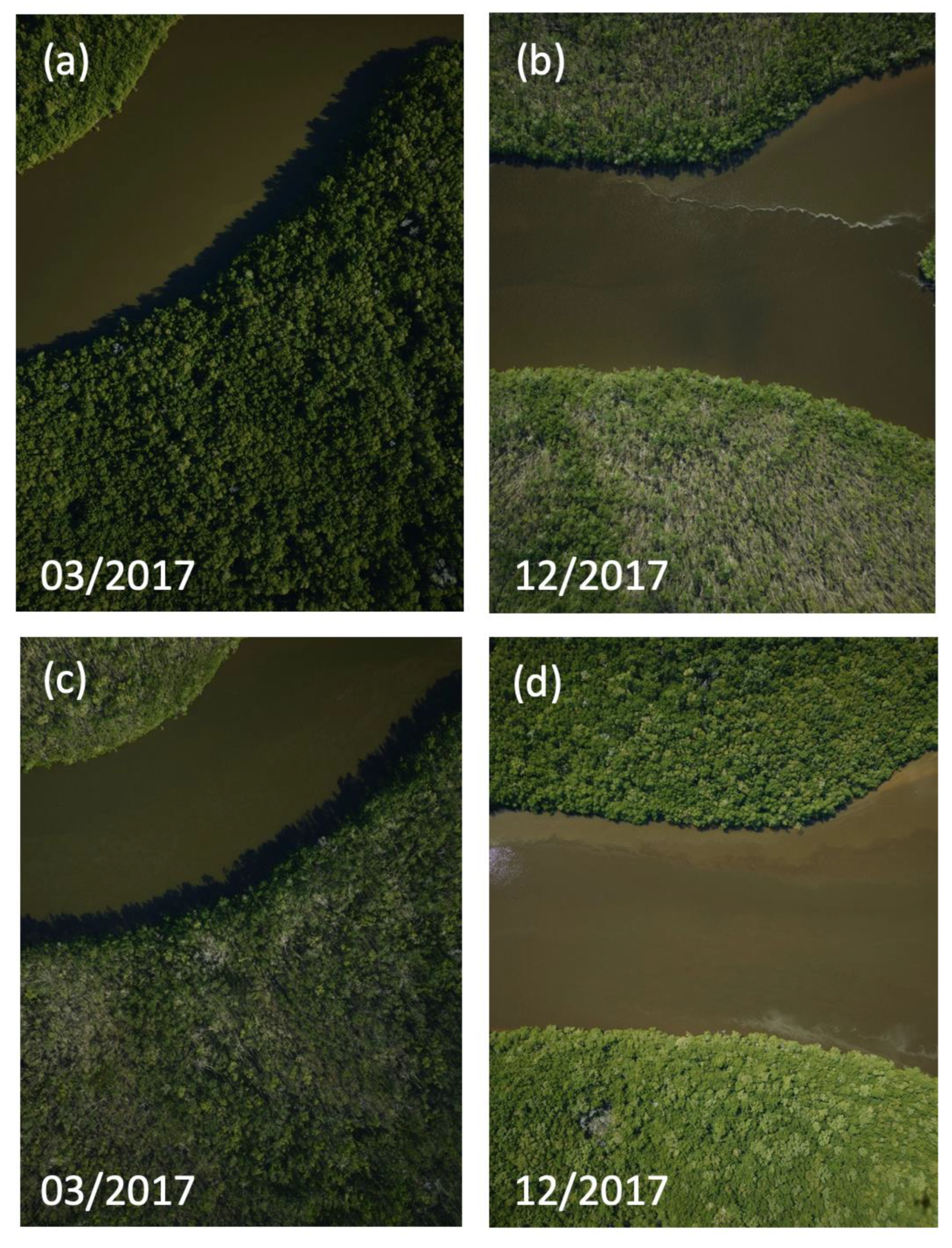



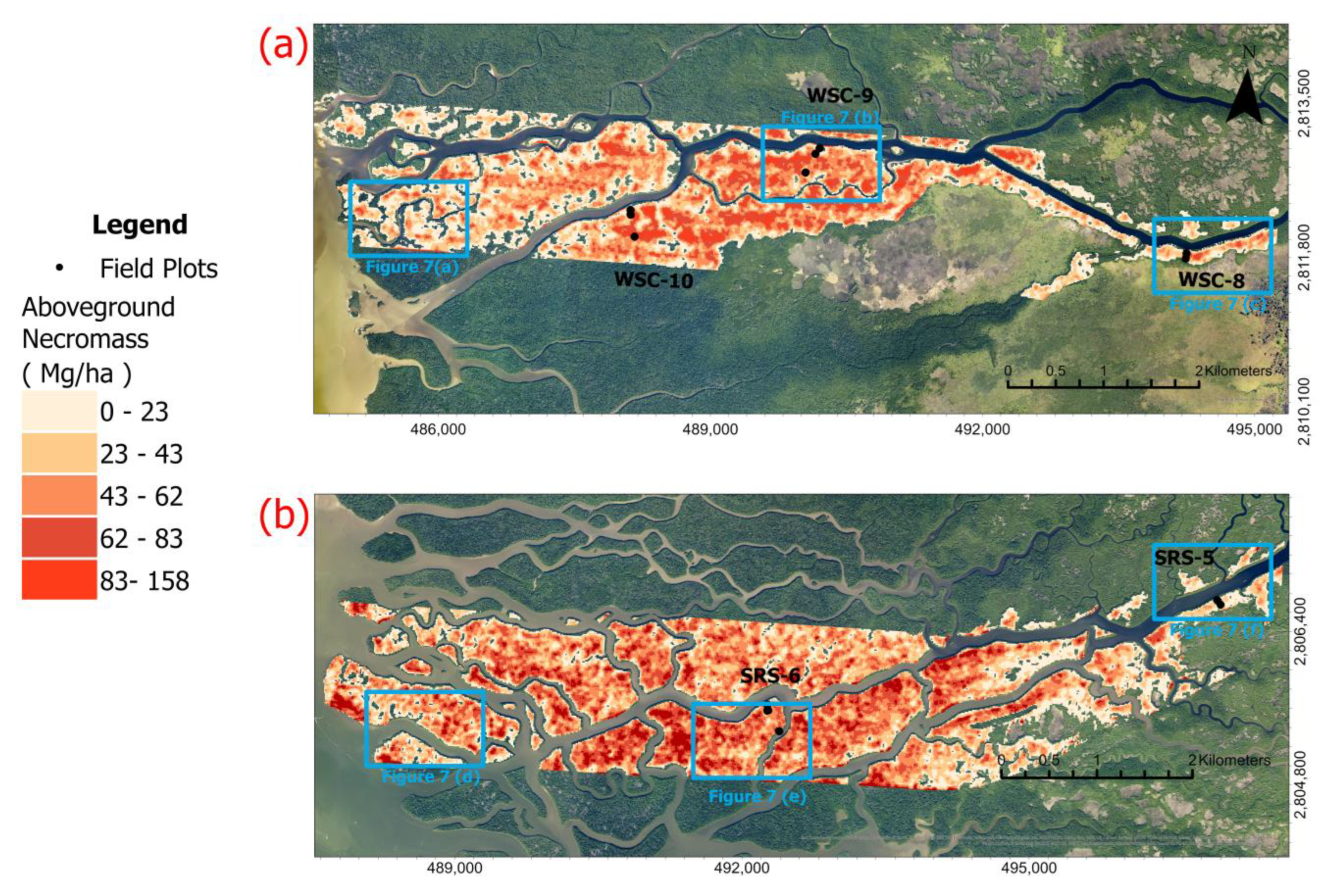

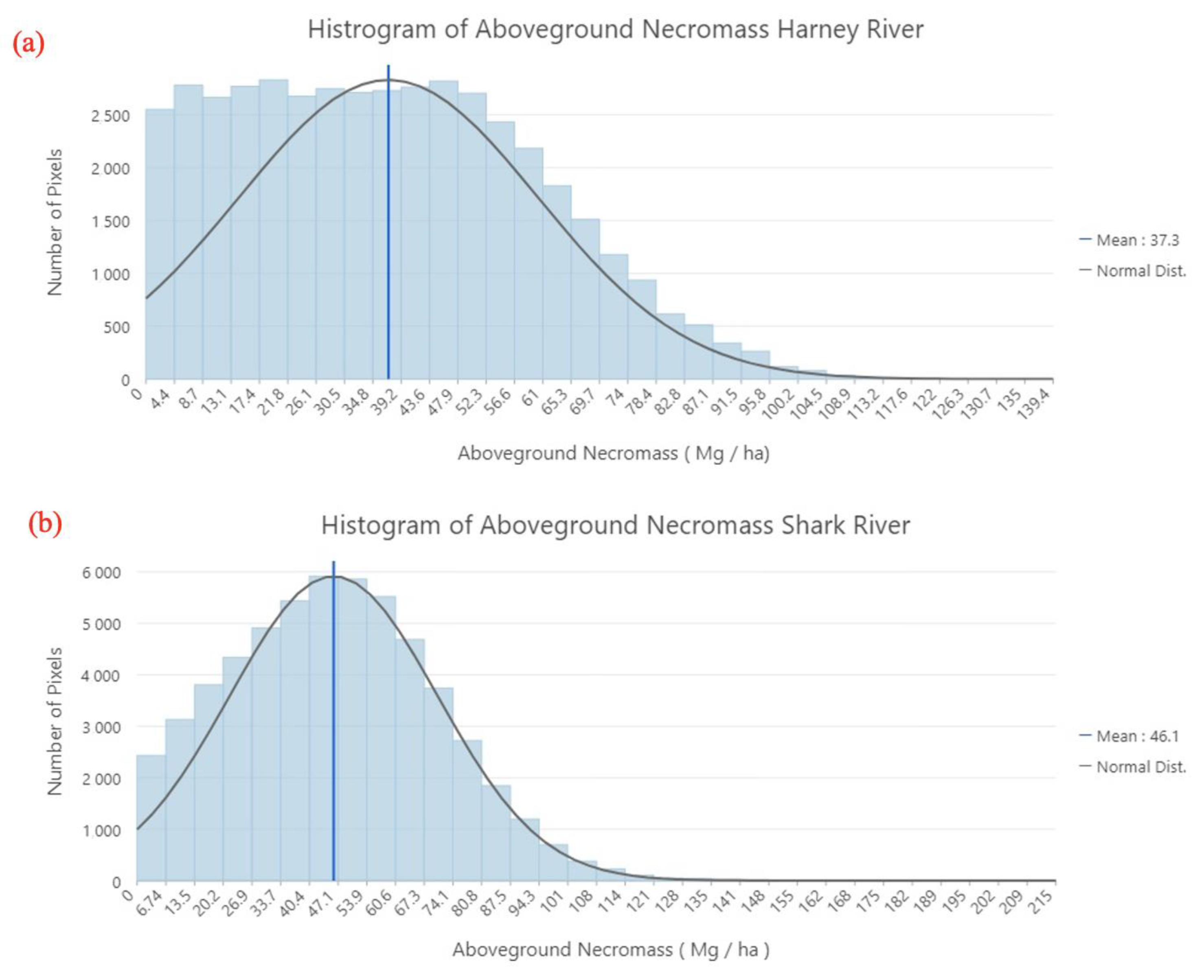
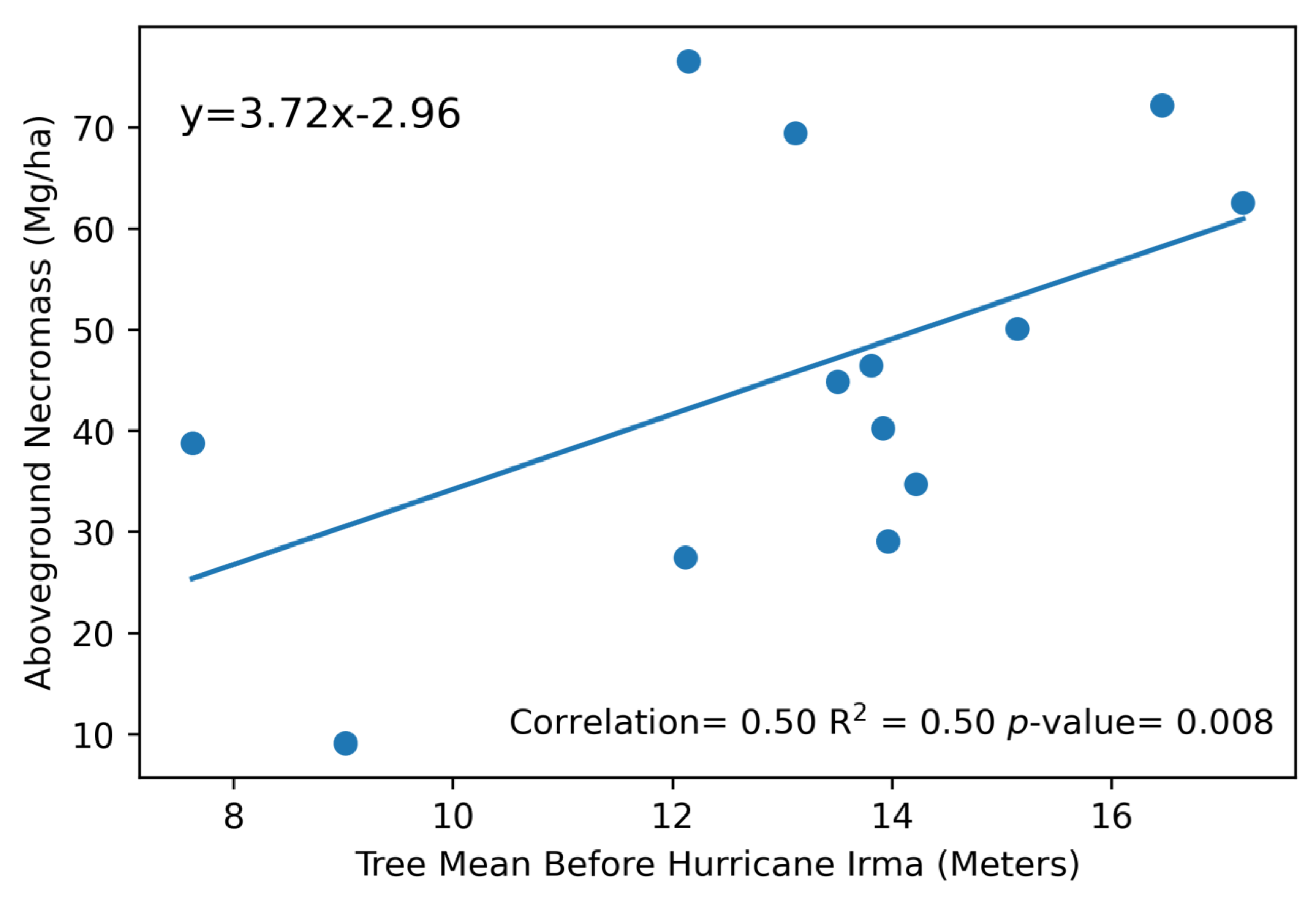
| Name | Description | Units |
|---|---|---|
| F-Cover | Fraction of first returns intercepted by trees | Fraction |
| Shrub Mean | Mean shrub returns heights Mean non-ground returns below 1.37 m | m |
| Tree Mean | Mean of tree returns heights Mean non-ground returns above 1.37 m | m |
| Pulse Density | Laser pulse density | Pulse/m2 |
| Canopy Height Model | The height or residual distance between the ground pulse returns and the top of the pulse return labeled as trees (>1.37 m) | m |
| River | Site | Field Plot | Total Pulse Returns before Hurricane Irma | Total Pulse Returns after Hurricane Irma | Difference in Pulse Returns |
|---|---|---|---|---|---|
| Shark River | SRS-5 | SRS-5-50 | 4850 | 3196 | −1654 |
| SRS-5-100 | 4009 | 2678 | −1331 | ||
| SRS-6 | SRS-6-50 | 4792 | 4088 | −704 | |
| SRS-6-100 | 4637 | 4159 | −478 | ||
| SRS-6-100 (2nd Plot) | 4954 | 4102 | −852 | ||
| SRS-6-350 | 2577 | 3200 | 623 | ||
| Harney River | WSC-8 | WSC-8-50 | 3043 | 3290 | 247 |
| WSC-8-100 | 1743 | 1789 | 46 | ||
| WSC-9 | WSC-9-50 | 2840 | 1139 | −1701 | |
| WSC-9-100 | 3064 | 2695 | −369 | ||
| WSC-9-350 | 2943 | 2514 | −429 | ||
| WSC-10 | WSC-10-50 | 1693 | 1938 | 245 | |
| WSC-10-100 | 1605 | 1638 | 33 | ||
| WSC-10-350 | 2438 | 2290 | −148 |
| River | Site | Field Plot | Mean WD (Mg/ha) | Mean AGN (Mg/ha) | Mean AGB (Mg/ha) | AGTM (Mg/ha) |
|---|---|---|---|---|---|---|
| Shark River | SRS-5 | SRS-5-50 | 30.7 | 16.4 | 140.7 | 157.0 |
| SRS-5-100 | 21.8 | 24.7 | 87.4 | 112.1 | ||
| SRS-6 | SRS-6-50 | 2.6 | 52.3 | 119.6 | 172.0 | |
| SRS-6-100 | N/A | 87.3 | N/A * | N/A * | ||
| SRS-6-100 (2nd Plot) | 40.9 | N/A | 60.6 | 60.57 | ||
| SRS-6-350 | 52.3 | 4.00 | 141.1 | 145.1 | ||
| Harney River | WSC-8 | WSC-8-50 | 3.0 | 63.5 | 59.3 | 122.8 |
| WSC-8-100 | 9.8 | 40.5 | 65.3 | 105.7 | ||
| WSC-9 | WSC-9-50 | 7.4 | 35.7 | 107.7 | 143.3 | |
| WSC-9-100 | 157.6 | 52.1 | 99.63 | 151.8 | ||
| WSC-9-350 | 22.7 | 9.4 | 136.3 | 145.7 | ||
| WSC-10 | WSC-10-50 | 23.7 | 57.6 | 99.6 | 157.2 | |
| WSC-10-100 | 84.3 | 35.8 | 56.8 | 92.60 | ||
| WSC-10-350 | 19.7 | 113.1 | 74.2 | 187.3 |
| River | Site | Field Plot | Mean Value of F-Cover (%) before Irma | Mean Value of F-Cover (%) after Irma | Change in F-Cover (%) | Percent Change in F-Cover |
|---|---|---|---|---|---|---|
| Shark River | SRS-5 | SRS-5-50 | 96.7% | 79.6% | −17.1% | −17.7% |
| SRS-5-100 | 96.1% | 83.8% | −12.3% | −12.8% | ||
| SRS-6 | SRS-6-50 | 93.8% | 60.0% | −33.8% | −36.0% | |
| SRS-6-100 | 96.4% | 65.7% | −30.7% | −31.8% | ||
| SRS-6-100 (Plot 2) | 96.4% | 65.7% | −30.7% | −31.8% | ||
| SRS-6-350 | 96.1% | 72.6% | −23.5% | −24.5% | ||
| Harney River | WSC-8 | WSC-8-50 | 96.7% | 61.5% | −35.2% | −36.4% |
| WSC-8-100 | 94.9% | 72.2% | −22.7% | −23.9% | ||
| WSC-9 | WSC-9-50 | 96.9% | 76.7% | −20.2% | −20.8% | |
| WSC-9-100 | 98.2% | 71.0% | −27.2% | −287.7% | ||
| WSC-9-350 | 97.8% | 75.7% | −22.1% | −22.6% | ||
| WSC-10 | WSC-10-50 | 94.7% | 69.6% | −25.1% | −26.5% | |
| WSC-10-100 | 95.0% | 70.3% | −24.7% | −26.0% | ||
| WSC-10-350 | 98.2% | 64.9% | −33.2% | −33.9% |
| River | Site | Field Plot | Mean AGN (MG/ha) | AGTM (Mg/ha) | Mean AGN/AGTM (%) | Modeled AGN (Mg/ha) | Modeled AGTM (Mg/ha) | Modeled AGN/Modeled AGTM (%) |
|---|---|---|---|---|---|---|---|---|
| Shark River | SRS-5 | SRS-5-50 | 16.4 | 157.0 | 10.5% | 19.7 | 141.3 | 13.9% |
| SRS-5-100 | 24.7 | 112.1 | 22.0% | 4.8 | 118.3 | 4.1% | ||
| SRS-6 | SRS-6-50 | 52.3 | 172.0 | 30.4% | 75.2 | 202.2 | 37.2% | |
| SRS-6-100 | 87.3 | N/A | N/A | 62.6 | 224.4 | 27.9% | ||
| SRS-6-100 (Plot 2) | N/A | 60.57 | N/A | 62.6 | 224.4 | 27.9% | ||
| SRS-6-350 | 4.00 | 145.1 | 2.8% | 40.3 | 138.9 | 29.0% | ||
| Harney River | WSC-8 | WSC-8-50 | 63.5 | 122.8 | 51.7% | 76.6 | 149.8 | 51.1% |
| WSC-8-100 | 40.5 | 105.7 | 38.3% | 38.8 | 78.5 | 49.4% | ||
| WSC-9 | WSC-9-50 | 35.7 | 143.3 | 24.9% | 29.1 | 124.1 | 23.4% | |
| WSC-9-100 | 52.1 | 151.8 | 34.3% | 50.1 | 174.0 | 28.8% | ||
| WSC-9-350 | 9.4 | 145.7 | 6.5% | 34.4 | 161.38 | 21.3% | ||
| WSC-10 | WSC-10-50 | 57.6 | 157.2 | 36.6% | 46.5 | 164.7 | 28.2% | |
| WSC-10-100 | 35.8 | 92.60 | 38.7% | 44.8 | 141.6 | 31.6% | ||
| WSC-10-350 | 113.1 | 187.3 | 60.4% | 67.0 | 164.2 | 40.8 | ||
| Mean | 29.8% | 29.6% |
Disclaimer/Publisher’s Note: The statements, opinions and data contained in all publications are solely those of the individual author(s) and contributor(s) and not of MDPI and/or the editor(s). MDPI and/or the editor(s) disclaim responsibility for any injury to people or property resulting from any ideas, methods, instructions or products referred to in the content. |
© 2023 by the authors. Licensee MDPI, Basel, Switzerland. This article is an open access article distributed under the terms and conditions of the Creative Commons Attribution (CC BY) license (https://creativecommons.org/licenses/by/4.0/).
Share and Cite
Chavez, S.; Wdowinski, S.; Lagomasino, D.; Castañeda-Moya, E.; Fatoyinbo, T.; Moyer, R.P.; Smoak, J.M. Estimating Structural Damage to Mangrove Forests Using Airborne Lidar Imagery: Case Study of Damage Induced by the 2017 Hurricane Irma to Mangroves in the Florida Everglades, USA. Sensors 2023, 23, 6669. https://doi.org/10.3390/s23156669
Chavez S, Wdowinski S, Lagomasino D, Castañeda-Moya E, Fatoyinbo T, Moyer RP, Smoak JM. Estimating Structural Damage to Mangrove Forests Using Airborne Lidar Imagery: Case Study of Damage Induced by the 2017 Hurricane Irma to Mangroves in the Florida Everglades, USA. Sensors. 2023; 23(15):6669. https://doi.org/10.3390/s23156669
Chicago/Turabian StyleChavez, Selena, Shimon Wdowinski, David Lagomasino, Edward Castañeda-Moya, Temilola Fatoyinbo, Ryan P. Moyer, and Joseph M. Smoak. 2023. "Estimating Structural Damage to Mangrove Forests Using Airborne Lidar Imagery: Case Study of Damage Induced by the 2017 Hurricane Irma to Mangroves in the Florida Everglades, USA" Sensors 23, no. 15: 6669. https://doi.org/10.3390/s23156669






